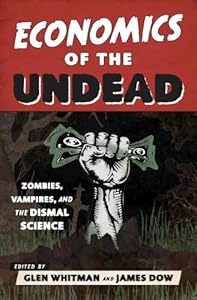This article on Haitian zombies, which includes a history of attempts to explain their existence in scientific terms, reminds us that zombie folklore is historically inseparable from slavery. Haitian zombies were created not by a virus, but by a sorcerer (bokor) whose black magic created undead laborers who would work indefinitely for free. This suggests that zombie labor might be analyzed in the same manner as slave labor.
In a justly famous (or infamous) book titled Time on the Cross, economists Robert Fogel and Stanley Engerman made the controversial claim that slavery in the American South was actually an efficient economic institution. It’s worth pointing out that “efficient” isn’t necessarily the same as “moral”; their argument was purely economic, not ethical. Nevertheless, the book unsurprisingly generated a great deal of criticism, from economists and others.
I can’t begin to summarize the whole debate initiated by Time on the Cross here, so I’ll focus on just one aspect that seems especially applicable to zombie labor: the allocation of labor to different types of work. One argument for why slave labor might actually be efficient in this regard is the Coase Theorem, which says that productive assets tend to be allocated to their most valuable uses regardless of initial ownership, provided that transaction costs are low. In this case, what that means is that regardless of whether a person owns himself (self-ownership) or is owned by others (slavery), his labor will end up being used for its best use, whether that is picking cotton, rolling cigars, or something else. Whoever owns the person’s labor, they will tend to use it — or sell it — for whatever purpose generates the highest value. If a person generates greater value in cigar-rolling than cotton-picking, then he will choose to roll cigars (if he owns himself), or he will be sold/rented to a cigar-rolling business (if someone else owns him). For essentially the same reason, we should expect zombie owners to use zombie labor in whatever way generates the highest value. (Zombies, being mindless, couldn’t be expected to sell their labor at all — but that only strengthens the case for ownership by someone else.)
What this analysis ignores (or rather, one thing it ignores) is the costliness of turning a free person into a slave and keeping them that way. First, there are the costs associated with capture and enforcement, such as slave ships, overseers, and fugitive slave hunters — all of which are valuable resources that could be used for other purposes. Second, and more subtly, there are the costs created by the incompatibility of slave labor with certain types of production. It is relatively easy to extract the maximum amount of cotton-picking from a slave. It is much harder to extract the maximum amount (and quality) of entrepreneurship or novel-writing or mathematics instruction from a slave. How can you tell whether they’re really doing their best? Extracting the optimal effort requires incentives, in the form of wages and profit shares — which represent partial movements away from pure slavery and toward self-ownership. Pure slavery, at least, tends to lock slave labor into lower-valued uses because higher-valued uses are incompatible with the means of enforcement.
Now back to the zombies. If zombies are people who were already dead of non-zombie causes and reanimated after the fact, there’s a really strong case for the efficiency of zombie labor, provided that the cost of reanimating them isn’t too large. If a zombie creates any value at all, that’s more value than a corpse in the grave would have created.
But as the linked article suggests, “real” zombies may be created through a two-step process. First, a bokor exposes a living person to a natural neurotoxin that creates the appearance of death. Second, after the person’s family and friends have been convinced of their death, the bokor applies “a drug made from the plant Datura stramonium, commonly called Jimsons Weed, or the ‘zombie cucumber,’ which has potent psychotropic properties and would keep them in a delirious, trance-like state vulnerable to mind control.”
If this is how zombies are indeed created, then they represent an extreme case of slavery — and its inefficiency. The relevant comparison is not between a zombie and a corpse in the grave, but between a zombie and a live human being. The application of the neurotoxin and the mind-control drug are analogous to the cost of slave ships, overseers, and fugitive hunters. But more importantly, the zombified individuals lose the ability to do sophisticated labor; they becomes mindless and non-communicative. As a result, their labor is confined to low-valued uses, which for at least some zombified individuals represents a notable reduction in economic value. As with regular slaves, zombified workers’ highest-valued uses may be incompatible with the means of enforcement.





